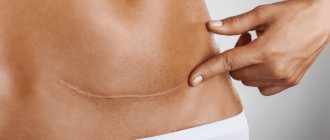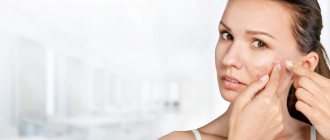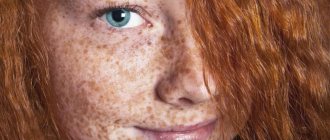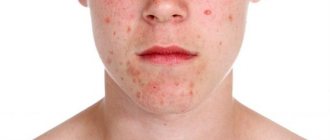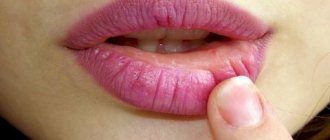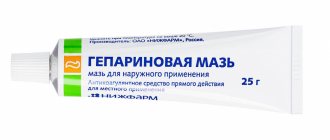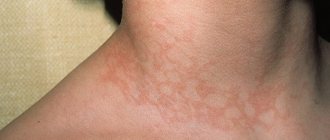Modern cosmetic procedures do an excellent job of treating age spots. At the same time, patients can choose tactics to their liking - be it hardware IPL or laser resurfacing procedures or injections of meso-cocktails with ascorbic acid.
Pigmentation can be present in a person from birth or acquired over the years.
Pigment spots do not harm the body as a whole, but they greatly disturb the aesthetics of the face. Previously, hyperpigmentation was characterized by the stereotypical term “liver spots,” and people with it on the face were considered sick in the hepatobiliary system. Indeed, the defect can arise from problems with the liver, but this is far from the only reason.
Here are a few reasons for the appearance of pigmentation:
- changes in the functioning of the thyroid gland, dysfunction of the thyroid gland;
- changes in the functions of the gallbladder and liver;
- excessive exposure to ultraviolet rays;
- hormonal imbalance in a woman’s body – pregnancy, taking hormonal medications;
- post-traumatic and post-burn factors;
- some skin diseases that are accompanied by low levels of melanin in some areas of the skin;
- Some medications, drugs and cosmetics can also contribute to the development of age spots.
Pigmentation or hyperpigmentation of the skin - what is it?
In fact, there is nothing wrong with this term and such a defect has absolutely nothing to do with any diseases.
The dictionary definition states that this can be called the uneven distribution of coloring pigments over the surface of the epidermis. In our case, we are talking specifically about a substance such as melanin, produced by a certain type of cell (melanocytes). Excessive accumulation or deficiency can cause hyperpigmentation or, conversely, tissue discoloration. This is how dots and even extensive formations appear, which are clearly visible to the naked eye. However, not only this substance has coloring ability; there are others. These can be lipochromes, bilirubin, lipofuscin and many others, which are products of cell metabolism.
Features of skin depigmentation
Depigmentation of the dermis indicates a violation of pigment metabolism in the human body. The disease can manifest itself in two forms: achromia (complete absence of coloring matter), hypochromia (deficiency of melanin in epithelial cells).
The appearance of lightened areas on the skin is considered by doctors to be the only sign of depigmentation. Since melanin is present in the hair, iris and inner ear, their color also changes. Depigmentation can be complete (lightened areas of the skin have no gaps and are continuous) and incomplete (uneven alternation of lightened spots with normal skin).
The disease is divided into persistent and temporary phases. In the first case, restoring the functioning of melanocytes is impossible. Temporary depigmentation can be treated with medication.
Content:
- Features of skin depigmentation
- The main causes of the disease
- Forms of depigmentation of the epidermis
- Depigmentation in children
- The main causes of skin depigmentation in children
- Diagnostics
- At-risk groups
- Preventive measures
Pigmentation (hyperpigmentation) in adults and children
People often wonder why and what causes pigment spots to appear on the body. There can be quite a few reasons, most of them will be answered in our article. Heredity may be a major factor. In such cases, visual defects appear from birth or at a very young age, because information about them is embedded in the DNA.
Therefore, there is no big difference when a person decides to deal with the problem. In the most extreme situations, when this seriously spoils the appearance, and, consequently, the quality of life, treatment with modern surgical techniques, for example, laser resurfacing, is indicated. However, these are extreme measures, and alternative options can always be found. Laennec Skincare – LNC offers to transform the skin at the cellular level, prevent and completely eliminate hyperpigmentation.
The best effect
We offer our patients procedures using the LumenisM22 IPL . The minimally invasive nature of the procedures performed on the LumenisM22 IPL guarantees a painless and fast recovery.
If a person has dark spots on the skin, you need to be especially attentive to yourself, constantly monitoring the proper care and protection of the epidermis. With the arrival of the beach season, do not forget that fair skin will always make a girl look a couple of years younger, so you should not exhaust your body under the hot rays of the sun, once again putting your skin at risk.
Pigmentation. Top articles:
- How to quickly get rid of age spots on the face?
- Care after the pigmentation removal procedure on Lumenis M22
- Photorejuvenation procedure on Lumenis M22
- Treatment of pigmentation on the face
- Laser removal of facial pigmentation
- Laser photorejuvenation
Telephone consultation is always free!
Leave your contact, we will tell you everything and offer a discount!
Send
Hair and eye coloring
Few people know that the color of the iris also directly depends on the amount produced, the depth of occurrence and the total mass of the main coloring pigment. The shade of the iris becomes darker when there is more melanin in the body and vice versa.
The situation with hair is approximately the same; the lighter it is, the fewer compounds are produced. Over the course of life, due to various internal and external circumstances, its release may intensify or subside due to various pathological or physical phenomena.
Face and body
There are a huge number of different reasons why skin hyperpigmentation appears. It can occur not only on the surface of the face, but also on the arms, back, legs, and abdomen. This may be due to genetics, various autoimmune disorders, excessive uncontrolled exposure to ultraviolet rays, insurmountable external circumstances, for example, the climatic characteristics of the region of residence, the environmental component, smoke or dust in cities.
Darkening on the stomach or back, on the arms or legs can appear after an inflammatory process in the epidermis. For some, insect bites cause light or dark areas of varying sizes that last a long time. Why is this happening? There are many prerequisites, they are worth discussing separately.
At-risk groups
Best materials of the month
- Coronaviruses: SARS-CoV-2 (COVID-19)
- Antibiotics for the prevention and treatment of COVID-19: how effective are they?
- The most common "office" diseases
- Does vodka kill coronavirus?
- How to stay alive on our roads?
Depigmentation is very often treated with medications. After eliminating the main cause of the spots, they disappear or become less visible on the skin. The exceptions are albinism and vitiligo. The spots do not cause pain or discomfort to a person. The only disadvantage of the pathology is aesthetic unattractiveness and the appearance of complexes.
Uneven skin coloring most often appears in people before the age of twenty. People aged 30-40 years very rarely seek medical help. A person's race does not play a special role in skin diseases. According to statistical reports, dermatological diseases develop several times less often in men than in women.
Risk groups include people: with a genetic predisposition to skin diseases; have experienced a severe stressful situation; with second and third degree burns; with severe sunburn; with autoimmune diseases. With constant visits to solariums, the risk of depigmentation of the dermis increases by 2-3 times.
The pathology is not accompanied by pain or itching. The only problem with vitiligo and albinism is the psychological factor associated with the aesthetic appearance of the spots.
Causes of age spots on the body
The mechanism is simple - melanocytes participate in tissue healing, help rapid regeneration, and stop oxidation from the effects of free radicals. However, “working” on a certain place, they at the same time significantly darken it, which is why a stain is formed.
Problems with improper redistribution of melanin can arise with long-term use of certain medications. In the process of treating one imperfection, a person also earns an additional one - ugly darkened or light areas. Antibiotics and oral contraceptives also sometimes cause different types of darkening of the surface of the dermis.
Anti-age drugs
Curacen Essence (20 fl x 2 ml)
Laennec – solution for injection
Bb Laboratories – Serum “Arcanum”
Premium set “Ideal facial skin. Healthy tone"
The main causes of the disease
There are acquired and congenital causes of this disease. They are associated with the lack of melanin in certain areas of the skin. In rare cases, epithelial cells do not have an important pigment at all; an example is albinism, which is congenital.
Acquired causes include: chronic skin diseases; inflammation; long-term treatment with corticosteroids; starvation; pregnancy period; lack of iron in the blood; autoimmune disorders. Also acquired factors are endocrine dysfunction and dermatological diseases such as leprosy, streptoderma and psoriasis.
Depigmentation can occur due to prolonged exposure of a person to ultraviolet rays. Doctors can diagnose a pathology that is caused by a burn or previous trauma with skin damage.
Types of skin pigmentation disorders
They can be either primary (congenital) or secondary, that is, they are actually a consequence of some process in the body or outside it. The intensity may increase or decrease over time.
Cutaneous-ocular albinism
This heterogeneous disease can most often be diagnosed in the fetus while still in the womb. If the diagnosis was not established in time, then the disease manifests itself immediately after birth. The main signs are depigmentation of the skin (milky-white tint), iris, hair, and other things. Often accompanied by deafness and even epilepsy, actinic (solar) keratosis.
People with this diagnosis have a high risk of developing tumors in the dermis, for example, under the influence of sunlight. Therefore, doctors recommend them powerful photoprotective creams, as well as other drugs containing many retinoids.
Hyperpigmentation
This phenomenon consists of a special concentration of skin pigment, a significant increase in its color compared to normal. It is caused by its excessive production due to various processes in the body. The main shade of the epidermis directly depends on melanocytes, which are responsible for the production of melanin in special formations called melanosomes. Tyrosine and its derivative tyrosinase, which is related to copper, are responsible for the synthesis.
First, promelanin appears, which, under the influence of another enzyme, oxidase, is already converted into the final substance. From its immature cells, melanocytes are produced, which are found mostly in the basal epidermal layer. It is noteworthy that representatives of the light-skinned race have exactly the same number of them as dark-skinned people. However, the coloring component penetrates into all layers of the dermis, including the stratum corneum.
The appearance of hyperpigmentation: hyperchromia
Sometimes it can be limited, that is, appear only in certain places. Such disorders also include chloasma and maculae, commonly called freckles.
These formations can be regular or irregular in shape. Most often they are yellowish, yellow-brown or even brownish-brown. They can be located in the facial area (in the majority of cases), but also dispersed throughout the body (disseminated position). The main cause of this skin defect is genetics.
Freckles
Maculae first appear in children of primary school or preschool age, most often after prolonged exposure to direct sunlight. These are neat, oval or round, brown or red spots, the size of which can vary between 1-10 millimeters in length. For many people with this feature, pigmentation is clearly visible in spring and summer, but in the cold season it fades and becomes barely noticeable.
Such macules do not pose any threat to health, and they are diagnosed using a visual examination. However, it is still better to maintain a certain degree of dermal care. In warm weather, you should definitely use creams and ointments with photoprotective ingredients and SPF filters. It is not customary to remove freckles, but many cosmetologists recommend whitening compounds and keratolytic agents.
For the qualitative elimination of such defects, the injection and non-injection drug CURACEN is effective, which can “override” the main prerequisites for starting the process of melanogenesis. After testing, it turned out that it can even be used for recovery after various aggressive procedures (peelings, scrubbing, acid exfoliation). Its cosmetic non-injection form – CURACEN Essence – is also perfect for this. Among the best-proven tone-evening products are specialized preparations from the brands Bb Laboratories, Laennec Skincare - LNC, PlaReceta. They are developed by pharmacists, which guarantees their effectiveness and safety.
Chloasma
Melasma, cutaneous melanosis or melasma - all this refers specifically to this phenomenon and is an excessive deposition of a dye in the epidermis. Usually it looks like symmetrical formations of irregular shape, located mainly on the face. They are often brighter and darker than freckles and have a very indirect relationship to genetics. There are only two reasons for the appearance of chloasma:
- Excessive accumulation of phagocytes in the papillary layer, which capture melanin coming directly from the epidermis and absorb it.
- Increased concentration of the coloring component in the cells of the basal layer.
Such formations occur, which do not appear on the surface in any way, due to friction, during pregnancy and gynecological diseases in women, due to pressure or due to the use of certain oral contraceptives.
Hypopigmentation
The process is characterized by the fact that a person develops very weakly pigmented skin. The reason usually lies in the insufficient production of that same melanin, or its complete absence, for which they even came up with a special term - depigmentation. Its total deficiency is considered albinism, and its partial deficiency is itself a subtype of hypochromia.
Vitiligo
Scientists have not yet figured out where this disease came from and what causes it. However, it is thoroughly known that this is an acquired anomaly, which is in no way related to genetic mutations, but is related to such characteristics. Those who suffer from vitiligo often have problems with the endocrine system (adrenal glands, thyroid gland, pituitary gland).
The disease looks like whitish, colorless spots all over the body, growing and merging together. Sometimes before this you can observe erythema, that is, some redness and mild inflammation. Sometimes even hair on their surface becomes discolored, but not always. Sensitivity in the affected areas increases, inflammation from the sun often occurs, redness and itching appear.
Doctors do not yet have any effective treatment for vitiligo. But therapy is always prescribed to reduce the rate of development of spots, as well as unpleasant symptoms. If the defect interferes with the appearance and is located on the face, it is recommended to use various cosmetics, for example, decorative dyes in general, and dihydroxyacetone in particular.
Incomplete albinism
A cutaneous-ocular hereditary disease can be complete, in contrast to a purely cutaneous one, or incomplete. It is characterized by a lack of color and is genetic, that is, congenital in nature. Main signs:
- Translucent iris of the eyes.
- Completely whitish or unusually light hair.
- Hypopigmentation of the fundus.
- Hypomelanosis or complete absence of color.
- Acute reaction to too bright light.
There are several undesirable consequences that can occur with this disease. The first is a significant deterioration in vision, and the second is complete intolerance to light. That is, a person simply cannot be in the sun even for a limited time. There is no treatment that completely cures albinism, but all unpainted areas should, if possible, be hidden from direct ultraviolet rays and regularly treated with high-quality protective agents.
Tuberous sclerosis
This is a genetic disease that is transmitted as a dominant autosomal trait. In almost everyone who suffers from it, it manifests itself in the form of spots devoid of dye, located mainly on the buttocks and torso. The pathology appears around the fourth year of life and is characterized by seizures, sebaceous adenoma and even mental retardation.
The shape of depigmented spots is oval, but can be elongated, and the number is from one to several dozen. Additionally, they can be placed across the body, as well as along the arms and legs. Diagnosis is most often carried out using a CT scan, and relatives who have similar marks or have seizures of unknown origin are also checked.
Neurofibromatosis
Recklinghausen's disease is also inherited, like the previous one. Most often it first appears in children around 3 years of age as small pale yellow-brown or beige spots on the body, arms and legs. Their diameter can easily reach 10-15 centimeters, but there are also small ones, up to 1-3.
Moynihan syndrome
Sometimes this disease is poetically called “leopard” and it is not at all accidental. Pathology is also transmitted through genes in a dominant manner. With it, the entire surface of the body is usually covered with limited brownish areas of small size, in which the melanin content is very high. In this case, the syndrome is accompanied by other symptoms:
- Growth retardation compared to peers.
- Pulmonary artery stenosis.
- Severe genital pathologies.
- Deformation of the face, disruption of normal coloring.
- Deafness.
Chloasma of pregnancy
The main sign and symptom of this disease are hypermelanotic areas on the epidermis, that is, ordinary dark spots. Interestingly, similar darkening also occurs in men. It occurs more often in those who have previously taken oral contraceptives.
Doctors recommend the use of vitamin C, nicotinic and folic acids, as well as the use of external local remedies, such as natural keratolytics and creams with a whitening effect (diluted citric acid, juice or vinegar, hydrogen peroxide).
Pigmented papillary skin dystrophy
The reasons may lie in the development of this disease, which is also called acanthosis nigricans. It is expressed in brownish and brownish-brown spots that have a velvety rather than smooth surface. This phenomenon is often observed in those who suffer from various types of oncology, diabetes mellitus, Cushing's syndrome, Addison's disease, pituitary adenoma and others.
Urticaria pigmentosa
Patients symptomatically develop spots and papules, mostly not turning into pustules, of a reddish-brown or yellow-brown hue. In infants, this type of disease occurs spontaneously and most often goes away on its own, but sometimes after many years. Such pathologies are treated by prescribing antihistamines, although no special effect can be expected.
How to deal with hyperpigmentation
Today there are many methods that will help even out skin color, but the purpose of one or another method depends on the severity of the problem and goals.
Unfortunately, if a person is predisposed to hyperpigmentation, then making the skin look young and even in color is quite difficult.
In cosmetology they use:
- special masks and creams with whitening effect;
- in some cases, peeling or grinding (acid or laser) is indicated;
- hardware IPL procedures.
Hardware methods are the most effective way to remove the appearance of pigment on the skin.
Treatment
There are various methods to get rid of unwanted coloring. Their choice should primarily depend on the pathology itself, the person’s age, and whether he or she has any other problems. Therefore, first of all, it is necessary to carry out a competent diagnosis, which is impossible without special equipment and experienced specialists.
Cosmetical tools
If the unwanted coloring is not a consequence of any disease, then you can use some cosmetic preparations. Effective creams and masks usually contain:
- parsley or jojoba extract;
- arbutin;
- kojic acid;
- vitamin C;
- hydroquinone.
It would be worth repeating that you should use any means only after consulting a doctor.
Cosmeceuticals
In addition to cosmetics, you can purchase effective, safe and high-quality placental preparations to eliminate various skin defects.
- Bb Laboratories - the line is highly effective due to the combination of biologically active substances, peptides, herbal extracts, hyaluronic acid and other components.
- GHC Placental Cosmetic is a series of products that saturates cells with beneficial biologically active compounds, activates the synthesis of collagen and elastin fibers, improves the regeneration process, and reduces wrinkles.
- PlaReceta & PiloPla - the line fights the signs of facial aging, restoring the dermis. The products are especially aimed at those with sensitive, dehydrated, flaky skin, providing effective care and maintaining youth.
- LAENNEC SkinCare - LNC is a placental and vitamin line aimed at eliminating age-related changes. It also helps in restoring the condition of the skin after photodamage. The products restore an even complexion, improve the condition of the skin during inflammation and prevent the formation of wrinkles.
Anti-age drugs
Bb Laboratories – Hyaluron-elastin-collagen extract
Laennec – solution for injection
Curacen Essence (20 fl x 2 ml)
Two-phase placental serum concentrate
Laser skin resurfacing
Often, girls and women choose similar salon procedures that help to quickly and without a trace cope with certain types of skin defects. The laser penetrates deeply into the epidermis and destroys melanin, eliminating everything quickly and safely. Problems usually do not arise after such “cleaning”, but you should only contact reliable and trusted specialists.
Diagnostics
Adult women and men who experience skin depigmentation should consult a dermatologist. This doctor diagnoses dermatological diseases and understands the issues of prevention and prevention of the development of serious pathologies. The specialist also studies the relationship between diseases and pathological and abnormal conditions.
The doctor may refer a patient with depigmentation of the skin to undergo a number of tests: allergy tests, blood tests for antibodies and antigens, scrapings, microflora cultures. The specialist may prescribe the patient a dermoscopic examination of skin formations.
Methods for examining human skin are: palpation (the doctor determines the density and turgor of the dermis, its temperature, the presence of swelling, nodules); assessment of the color of the epidermis (the doctor visually assesses the condition of the nails, mucous membranes, hair, and looks for rashes, peeling, cracks and ulcers).
If a specialist has discovered any pathologies, it is worth taking into account their localization, symmetry, size, shape, color, mobility, and density. After examination and receiving the results of laboratory tests and studies, the dermatologist writes a conclusion and prescribes an effective therapeutic course.

